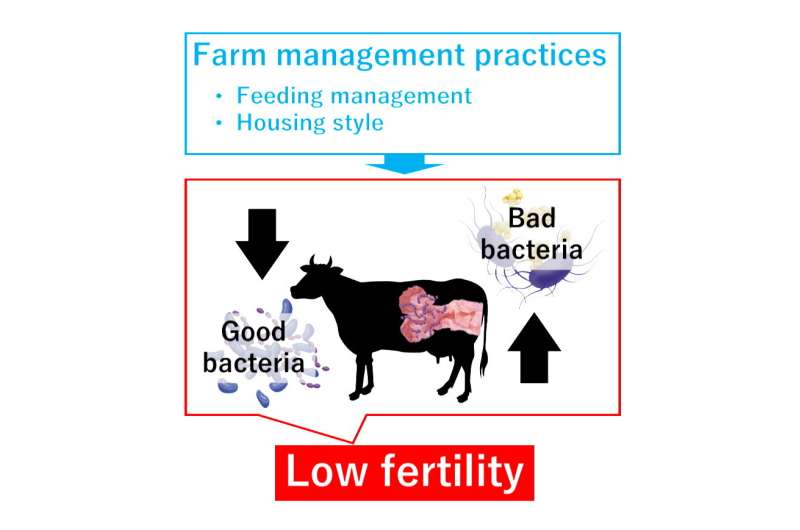This article has been reviewed according to Science X's editorial process and policies. Editors have highlighted the following attributes while ensuring the content's credibility:
fact-checked
trusted source
proofread
Deciphering the association between uterine microbiota and fertility in dairy cows

Reduced fertility prolongs the interval from calving to conception in dairy cows, resulting in significant economic losses to dairy farms. Up to 25% of cows are culled due to reproductive failure, and this accounts for a larger proportion than that caused by other major factors, including mastitis and lameness.
A variety of factors are considered to cause low fertility in cows, including farm management factors like estrus detection, nutritional control, and cowshed environment, as well as cow-specific factors like reproductive tract infections, endocrine disorders, and defective ova. However, there are cases of low fertility where the cause is undetermined, which results in economic losses. Identifying the factors associated with low fertility may help in the development of effective future strategies for improving reproductive performance in dairy farms.
Although the uterus has long been thought to be free of microbes, advancements in next-generation sequencing technology have revealed the existence of "uterine microbiota," unique to the uterine environment. Many studies on uterine microbiota have been conducted in humans, and fertility has been confirmed to vary according to the diversity of the uterine microbial population.
Could this knowledge be extended to reared animals? To find out, Takuya Yagisawa, Section Chief at the Hokkaido Agriculture Mutual Aid Association, Japan, and Dr. Jumpei Uchiyama, Associate Professor at Okayama University, Japan, along with their teams of researchers, collaborated to investigate the association between low fertility and uterine microbiota in dairy cows.
Dairy farms set a voluntary waiting period (VWP) between calving and the first artificial insemination (AI; the procedure of injecting semen into the uterus) as a period for uterine involution in preparation for the next pregnancy. In cows, while the uterine microbiota has been studied in terms of postpartum uterine inflammation, little is understood about its association with fertility following the VWP. This is where the new study comes in.
Giving further insights into their work, Yagisawa says, "We used a metataxonomic approach to analyze the uterine microbiota using endometrial tissue biopsy samples from dairy cows."
The team used 16S rRNA gene amplicon sequencing to identify the various types of bacteria present in the sampled uterine tissues. Next, microbiota data obtained from 69 cows bred on four commercial dairy farms were analyzed. The researchers then compared the microbial diversity of the samples with respect to the farm, housing style, and feeding management practices. Further, they went on to correlate the uterine microbiota data with parity (the number of deliveries) and the frequency of AI to conception for each cow.
The findings of their study have been published in Microbiology Spectrum on April 26, 2023.
The findings revealed significant differences in farm management-related factors (i.e., housing style and feeding management) across the four farms. Notably, while these differences correlated with variations in uterine microbiota, no significant differences were observed with respect to AI frequency as related to conception and parity.
Next, to eliminate the effects of variations in farm management practices among farms, the researchers examined the correlation between fertility and uterine microbiota using data obtained from 31 cows from a single dairy farm. Cows that conceived within three AIs were considered to have normal fertility, and cows that needed more than three AIs were considered to have low fertility.
The data obtained in this study strongly suggests that uterine microbiota changes in relation to the fertility of cows. Microbial diversity correlates with AI frequency to conception, and the bacterial taxon Arcobacter was observed to increase its compositional rates. Furthermore, bacterial associations differed between normal- and low-fertility cows.
Overall, these findings suggest that farm-to-farm variations can have a major influence on the diversity of uterine microbiota in dairy cows. Moreover, the composition of uterine microbiota changes in relation to fertility in cows.
Uchiyama concludes with the applications of their work by saying, "We hope that further research will establish uterine microbiome testing as a new approach to diagnosing the causes of low fertility and contribute to improved reproductive management in animal husbandry."
More information: Takuya Yagisawa et al, Metataxonomic Analysis of the Uterine Microbiota Associated with Low Fertility in Dairy Cows Using Endometrial Tissues Prior to First Artificial Insemination, Microbiology Spectrum (2023). DOI: 10.1128/spectrum.04764-22
Provided by Okayama University




















